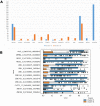From multi-omics integration towards novel genomic interaction networks to identify key cancer cell line characteristics
- PMID: 34006939
- PMCID: PMC8131752
- DOI: 10.1038/s41598-021-90047-3
From multi-omics integration towards novel genomic interaction networks to identify key cancer cell line characteristics
Abstract
Cancer is a complex disease where cancer cells express epigenetic and transcriptomic mechanisms to promote tumor initiation, progression, and survival. To extract relevant features from the 2019 Cancer Cell Line Encyclopedia (CCLE), a multi-layer nonnegative matrix factorization approach is used. We used relevant feature genes and DNA promoter regions to construct genomic interaction network to study gene-gene and gene-DNA promoter methylation relationships. Here, we identified a set of gene transcripts and methylated DNA promoter regions for different clusters, including one homogeneous lymphoid neoplasms cluster. In this cluster, we found different methylated transcription factors that affect transcriptional activation of EGFR and downstream interactions. Furthermore, the hippo-signaling pathway might not function properly because of DNA hypermethylation and low gene expression of both LATS2 and YAP1. Finally, we could identify a potential dysregulation of the CD28-CD86-CTLA4 axis. Characterizing the interaction of the epigenome and the transcriptome is vital for our understanding of cancer cell line behavior, not only for deepening insights into cancer-related processes but also for future disease treatment and drug development. Here we have identified potential candidates that characterize cancer cell lines, which give insight into the development and progression of cancers.
Conflict of interest statement
The authors declare no competing interests.
Figures





Similar articles
-
Impact of mutations in DNA methylation modification genes on genome-wide methylation landscapes and downstream gene activations in pan-cancer.BMC Med Genomics. 2020 Feb 24;13(Suppl 3):27. doi: 10.1186/s12920-020-0659-4. BMC Med Genomics. 2020. PMID: 32093698 Free PMC article.
-
Integrative genomics analysis reveals the multilevel dysregulation and oncogenic characteristics of TEAD4 in gastric cancer.Carcinogenesis. 2014 May;35(5):1020-7. doi: 10.1093/carcin/bgt409. Epub 2013 Dec 9. Carcinogenesis. 2014. PMID: 24325916
-
Promoter Hypermethylation of LATS2 Gene in Oral Squamous Cell Carcinoma (OSCC) Among North Indian Population.Asian Pac J Cancer Prev. 2020 May 1;21(5):1283-1287. doi: 10.31557/APJCP.2020.21.5.1283. Asian Pac J Cancer Prev. 2020. PMID: 32458634 Free PMC article.
-
Function and cancer genomics of FAT family genes (review).Int J Oncol. 2012 Dec;41(6):1913-8. doi: 10.3892/ijo.2012.1669. Epub 2012 Oct 17. Int J Oncol. 2012. PMID: 23076869 Free PMC article. Review.
-
Decoding transcriptional states in cancer.Curr Opin Genet Dev. 2017 Apr;43:82-92. doi: 10.1016/j.gde.2017.01.003. Epub 2017 Jan 24. Curr Opin Genet Dev. 2017. PMID: 28129557 Review.
Cited by
-
Zinc Finger Proteins in the War on Gastric Cancer: Molecular Mechanism and Clinical Potential.Cells. 2023 May 4;12(9):1314. doi: 10.3390/cells12091314. Cells. 2023. PMID: 37174714 Free PMC article. Review.
-
State of the Art of Genomic Technology in Toxicology: A Review.Int J Mol Sci. 2023 Jun 1;24(11):9618. doi: 10.3390/ijms24119618. Int J Mol Sci. 2023. PMID: 37298568 Free PMC article. Review.
References
MeSH terms
LinkOut - more resources
Full Text Sources
Other Literature Sources
Medical
Research Materials
Miscellaneous

